Have Climate Factor Changes Jeopardized the Value of Qinghai Grassland Ecosystem Services within the Grass–Animal Balance?
Abstract
1. Introduction
2. Theoretical Analysis and Research Hypothesis
2.1. The Role of Climate Factor Change in the Value of Grassland Ecological Services
2.2. The Mediating Role of the Grass–Animal Balance
2.3. Heterogeneity in Space
2.3.1. Spatial-Based Heterogeneity Test
2.3.2. Heterogeneity of the Duration of Low Grassland Carrying Pressure Index
3. Research Design
3.1. Sample Selection and Data Sources
3.2. Variable Measures
3.2.1. Grass–Animal Balance
3.2.2. Ecosystem Service Value Calculation Model
3.2.3. Baseline Model and Mediation Effect Model
4. Results
4.1. Spatial and Temporal Analysis of Ecosystem Service Value of Plateau Grassland
4.2. Benchmark Regression Results
4.3. Robustness Tests
4.4. Heterogeneity Test
4.5. Analysis of the Mechanism of Action
5. Discussion
6. Conclusions and Recommendations for Countermeasures
6.1. Conclusions
6.2. Suggestions and Shortcomings
Author Contributions
Funding
Institutional Review Board Statement
Informed Consent Statement
Data Availability Statement
Conflicts of Interest
References
- Li, H.M.; Wang, X.C.; Zhao, X.F.; Qi, Y. Understanding systemic risk induced by climate change. Adv. Clim. Change Res. 2021, 12, 384–394. [Google Scholar] [CrossRef]
- Sheng, Z.G.; Zhu, X.Z.; Hui, W.Y. Adaptation of terrestrial ecosystems to global change. Adv. Earth Sci. 2004, 19, 642. [Google Scholar]
- Zhan, W.; Du, D.; Ding, J.; Zhang, W.; Zheng, M.; Li, L.; Kong, Q.; Chen, M.; Shi, F.; Xu, Z. Research on urban safety early warning systems and emergency response mechanisms in snowstorms. Emerg. Manag. Sci. Technol. 2023, 3, 10. [Google Scholar] [CrossRef]
- Wang, J.; Liu, Y.; Cao, W.; Li, W.; Wang, X.; Zhang, D.; Shi, S.; Pan, D.; Liu, W. Effects of grazing exclusion on soil respiration components in an alpine meadow on the north-eastern Qinghai-Tibet Plateau. CATENA 2020, 194, 104750. [Google Scholar] [CrossRef]
- Guo, Y.R.; Ning, J.; Lou, S.N.; Zhang, C.; Zhu, W.H.; Hou, F.J. Grazing regulates soil N cycling of annual pastures by enhancing soil N turnover in arid climate condition. Land Degrad. Dev. 2023, 34, 5733–5743. [Google Scholar] [CrossRef]
- Bai, L.; Tian, J.; Peng, Y.; Huang, Y.; He, X.; Bai, X.; Bai, T. Effects of climate change on ecosystem services and their components in southern hills and northern grasslands in China. Environ. Sci. Pollut. Res. 2021, 28, 44916–44935. [Google Scholar] [CrossRef]
- Gao, H.M.; Jiang, F.; Chi, X.W.; Li, G.Y.; Cai, Z.Y.; Qin, W.; Zhang, J.J.; Wu, T.; Zhang, T.Z. The carrying pressure of livestock is higher than that of large wild herbivores in Yellow River source area, China. Ecol. Model. 2020, 431, 109163. [Google Scholar] [CrossRef]
- Ren, Y.H.; Zhu, Y.P.; Baldan, D.; Fu, M.D.; Wang, B.; Li, J.S.; Chen, A.P. Optimizing livestock carrying capacity for wild ungulate-livestock coexistence in a Qinghai-Tibet Plateau grassland. Sci. Rep. 2021, 11, 3635. [Google Scholar] [CrossRef]
- Xu, Y.; Xiao, F. Assessing Changes in the Value of Forest Ecosystem Services in Response to Climate Change in China. Sustainability 2022, 14, 4773. [Google Scholar] [CrossRef]
- Fenta, A.A.; Tsunekawa, A.; Haregeweyn, N.; Tsubo, M.; Yasuda, H.; Shimizu, K.; Kawai, T.; Ebabu, K.; Berihun, M.L.; Sultan, D.; et al. Cropland expansion outweighs the monetary effect of declining natural vegetation on ecosystem services in sub-Saharan Africa. Ecosyst. Serv. 2020, 45, 101154. [Google Scholar] [CrossRef]
- Li, Q.F.; Wang, L.; Du, G.M.; Faye, B.; Li, Y.K.; Li, J.C.; Liu, W.; Qu, S.J. Dynamic Variation of Ecosystem Services Value under Land Use/Cover Change in the Black Soil Region of Northeastern China. Int. J. Environ. Res. Public Health 2022, 19, 7533. [Google Scholar] [CrossRef] [PubMed]
- Zheng, W.X.; Zhang, J. Study on the Spatial and Temporal Evolution of Ecosystem Service Values and Driving Mechanism in the Yan River Basin from 1990 to 2020. Sustainability 2023, 15, 12550. [Google Scholar] [CrossRef]
- He, Z.; Shang, X.; Zhang, T.; Yun, J. Coupled regulatory mechanisms and synergy/trade-off strategies of human activity and climate change on ecosystem service value in the loess hilly fragile region of northern Shaanxi, China. Ecol. Indic. 2022, 143, 109325. [Google Scholar] [CrossRef]
- Costanza, R.; d’Arge, R.; de Groot, R.; Farber, S.; Grasso, M.; Hannon, B.; Limburg, K.; Naeem, S.; O’Neill, R.V.; Paruelo, J.; et al. The value of the world’s ecosystem services and natural capital. Nature 1997, 387, 253–260. [Google Scholar] [CrossRef]
- Richter, F.; Jan, P.; El Benni, N.; Lüscher, A.; Buchmann, N.; Klaus, V.H. A guide to assess and value ecosystem services of grasslands. Ecosyst. Serv. 2021, 52, 101376. [Google Scholar] [CrossRef]
- VanderWilde, C.P.; Newell, J.P. Ecosystem services and life cycle assessment: A bibliometric review. Resour. Conserv. Recycl. 2021, 169, 105461. [Google Scholar] [CrossRef]
- Nemec, K.T.; Raudsepp-Hearne, C. The use of geographic information systems to map and assess ecosystem services. Biodivers. Conserv. 2013, 22, 1–15. [Google Scholar] [CrossRef]
- Terrado, M.; Acuna, V.; Ennaanay, D.; Tallis, H.; Sabater, S. Impact of climate extremes on hydrological ecosystem services in a heavily humanized Mediterranean basin. Ecol. Indic. 2014, 37, 199–209. [Google Scholar] [CrossRef]
- 19. Ding, X.; Liu, H.; Zhang, J.; Shen, Y.; Yang, G. Does the local government multi-objective competition intensify the transfer of polluting industries in the Yangtze River Economic Belt? Environ. Res. 2024, 245, 118074. [Google Scholar]
- Müller, F.; Bicking, S.; Ahrendt, K.; Dang, K.B.; Zelen, J. Assessing ecosystem service potentials to evaluate terrestrial, coastal and marine ecosystem types in Northern Germany—An expert-based matrix approach. Ecol. Indic. 2020, 112, 106116. [Google Scholar] [CrossRef]
- Schroter, D.; Cramer, W.; Leemans, R.; Prentice, I.; Araujo, M.; Arnell, N.; Bondeau, A.; Bugmann, H.; Carter, T.; Gracia, C. Ecosystem service supply and vulnerability to global change in Europe. Science 2005, 310, 1333–1337. [Google Scholar] [CrossRef] [PubMed]
- Briner, S.; Elkin, C.; Huber, R. Evaluating the relative impact of climate and economic changes on forest and agricultural ecosystem services in mountain regions. J. Environ. Manag. 2013, 129, 414–422. [Google Scholar] [CrossRef] [PubMed]
- Alva-Basurto, J.C.; Arias-González, J.E. Modelling the effects of climate change on a Caribbean coral reef food web. Ecol. Model. 2014, 289, 1–14. [Google Scholar] [CrossRef]
- Rocca, M.E.; Miniat, C.F.; Mitchell, R.J. Introduction to the regional assessments: Climate change, wildfire, and forest ecosystem services in the USA. For. Ecol. Manag. 2014, 327, 265–268. [Google Scholar] [CrossRef]
- Dai, E.; Yin, L.; Wang, Y.; Ma, L.; Tong, M. Quantitative Assessment of the Relative Impacts of Land Use and Climate Change on the Key Ecosystem Services in the Hengduan Mountain Region, China. Sustainability 2020, 12, 4100. [Google Scholar] [CrossRef]
- Peng, J.; Tian, L.; Zhang, Z.; Zhao, Y.; Meersmans, J. Distinguishing the impacts of land use and climate change on ecosystem services in a karst landscape in China. Ecosyst. Serv. 2020, 46, 101199. [Google Scholar] [CrossRef]
- Sun, Z.G.; Sun, C.M.; Zhou, W.; Ju, W.M.; Li, J.L. Classification and Net Primary Productivity of the Southern China’s Grasslands Ecosystem Based on Improved Comprehensive and Sequential Classification System (CSCS) Approach. J. Integr. Agric. 2014, 13, 893–903. [Google Scholar] [CrossRef]
- Reside, A.E.; Vanderwal, J.; Moran, C. Trade-offs in carbon storage and biodiversity conservation under climate change reveal risk to endemic species. Biol. Conserv. 2017, 207, 9–16. [Google Scholar] [CrossRef]
- Linlin, G.; Xiaohua, G.; Yang, D.; Zhenqian, W.; Fu, G.; Fang, W. Increased growth of Qinghai spruce in northwestern China during the recent warming hiatus. Agric. For. Meteorol. 2018, 260, 9–16. [Google Scholar]
- Mina, M.; Bugmann, H.; Cordonnier, T.; Irauschek, F.; Klopcic, M.; Pardos, M.; Cailleret, M. Future ecosystem services from European mountain forests under climate change. J. Appl. Ecol. 2017, 54, 389–401. [Google Scholar] [CrossRef]
- Sarukhan, J.; Whyte, A.; Hassan, R.; Scholes, R.; Ash, N.; Carpenter, S.T.; Pingali, P.L.; Bennett, E.M.; Zurek, M.B.; Chopra, K. Millenium Ecosystem Assessment: Ecosystems and Human Well-Being; Island Press: Washington, DC, USA, 2005. [Google Scholar]
- Bestelmeyer, B.T.; Estell, R.E.; Havstad, K.M. Big Questions Emerging from a Century of Rangeland Science and Management. Rangel. Ecol. Manag. 2012, 65, 543–544. [Google Scholar] [CrossRef]
- Shao, Q.; Cao, W.; Fan, J.; Huang, L.; Xu, X. Effects of an ecological conservation and restoration project in the Three-River Source Region, China. J. Geogr. Sci. 2017, 27, 183–204. [Google Scholar] [CrossRef]
- Zhang, J.; Zhang, L.; Liu, W.; Qi, Y.; Wo, X. Livestock-carrying capacity and overgrazing status of alpine grassland in the Three-River Headwaters region, China. J. Geogr. Sci. 2014, 24, 303–312. [Google Scholar] [CrossRef]
- Song, X.P. Global Estimates of Ecosystem Service Value and Change: Taking Into Account Uncertainties in Satellite-based Land Cover Data. Ecol. Econ. 2018, 143, 227–235. [Google Scholar] [CrossRef]
- Egoh, B.; Rouget, M.; Reyers, B.; Knight, A.T.; Cowling, R.M.; Jaarsveld, A.S.V.; Welz, A. Integrating Ecosystem Services into Conservation Assessments: A Review; Elsevier: Amsterdam, The Netherlands, 2007. [Google Scholar]
- Xie, G.; Zhang, C.; Zhen, L.; Zhang, L. Dynamic changes in the value of China’s ecosystem services–ScienceDirect. Ecosyst. Serv. 2017, 26, 146–154. [Google Scholar] [CrossRef]
- Yang, J.; Huang, X. The 30 m annual land cover dataset and its dynamics in China from 1990 to 2021. Earth Syst. Sci. Data 2022, 13, 3907–3925. [Google Scholar] [CrossRef]
- Gao, J.; Zhao, X.-Q.; Liu, W.-T.; Yang, X.-X.; Zhang, C.-P.; Yu, Y.; Cao, Q.; Liu, Y.-Z.; Zhang, X.; Dong, Q.-M. Spatio-temporal analysis of the alpine grassland carrying capacity in Qinghai Province considering a supply-consumption relationship. Acta Prataculturae Sin. 2023, 32, 1. [Google Scholar]
- NY/T635-2002; Calculation of Proper Carrying Capacity of Rangelands. Agricultural Industry Standard of the People’s Republic of China: Beijing, China, 2002.
- Meng, L.I.; Yong-Tao, H.E.; Lin-Bo, Z.; Jian, S.; Pei-Li, S.; Xian-Zhou, Z. Dynamics of Grassland ANPP and Its’ Relationship with Climate Change and Carrying Capacity in the Three River Headwater Region. Chin. J. Grassl. 2017, 39, 49–56. [Google Scholar]
- Costanza, R.; Groot, R.D.; Sutton, P.; Ploeg, S.V.D.; Anderson, S.J.; Kubiszewski, I.; Farber, S.; Turner, R.K. Changes in the Global Value of Ecosystem Services; Elsevier: Amsterdam, The Netherlands, 2014. [Google Scholar]
- Brander, L.M.; de Groot, R.; Schägner, J.P.; Guisado-Goñi, V.; van ‘t Hoff, V.; Solomonides, S.; McVittie, A.; Eppink, F.; Sposato, M.; Do, L.; et al. Economic values for ecosystem services: A global synthesis and way forward. Ecosyst. Serv. 2024, 66, 101606. [Google Scholar] [CrossRef]
- Wang, H.; Zhou, S.; Li, X.; Liu, H.; Chi, D.; Xu, K. The influence of climate change and human activities on ecosystem service value. Ecol. Eng. 2016, 87, 224–239. [Google Scholar] [CrossRef]
- Xu, Y.; Xiao, F.; Liao, Y. Assessment of Grassland Ecosystem Service Value in Response to Climate Change in China. Diversity 2022, 14, 160. [Google Scholar] [CrossRef]
- Pettinotti, L.; de Ayala, A.; Ojea, E. Benefits from Water Related Ecosystem Services in Africa and Climate Change. Ecol. Econ. 2018, 149, 294–305. [Google Scholar] [CrossRef]
- Ren, H.; Liu, Y.; Wen, Z.; Shi, H.; Zhou, R.; Wang, Z.; Kareem, H.A.; Zhang, W. Untangling the effects of climate variation and human interference on grassland dynamics in North China. Land Degrad. Dev. 2024, 35, 467–483. [Google Scholar] [CrossRef]
- Zhang, J.; Wang, F.; Ding, X. Can agricultural mechanization promote carbon reduction in countries along the Belt and Road? J. Environ. Plan. Manag. 2024, 1–23. [Google Scholar] [CrossRef]
- Sannigrahi, S.; Zhang, Q.; Joshi, P.K.; Sutton, P.C.; Keesstra, S.; Roy, P.S.; Pilla, F.; Basu, B.; Wang, Y.; Jha, S.; et al. Examining effects of climate change and land use dynamic on biophysical and economic values of ecosystem services of a natural reserve region. J. Clean. Prod. 2020, 257, 120424. [Google Scholar] [CrossRef]
- Li, J.; Wang, W.; Hu, G.; Wei, Z. Changes in ecosystem service values in Zoige Plateau, China. Agric. Ecosyst. Environ. 2010, 139, 766–770. [Google Scholar] [CrossRef]
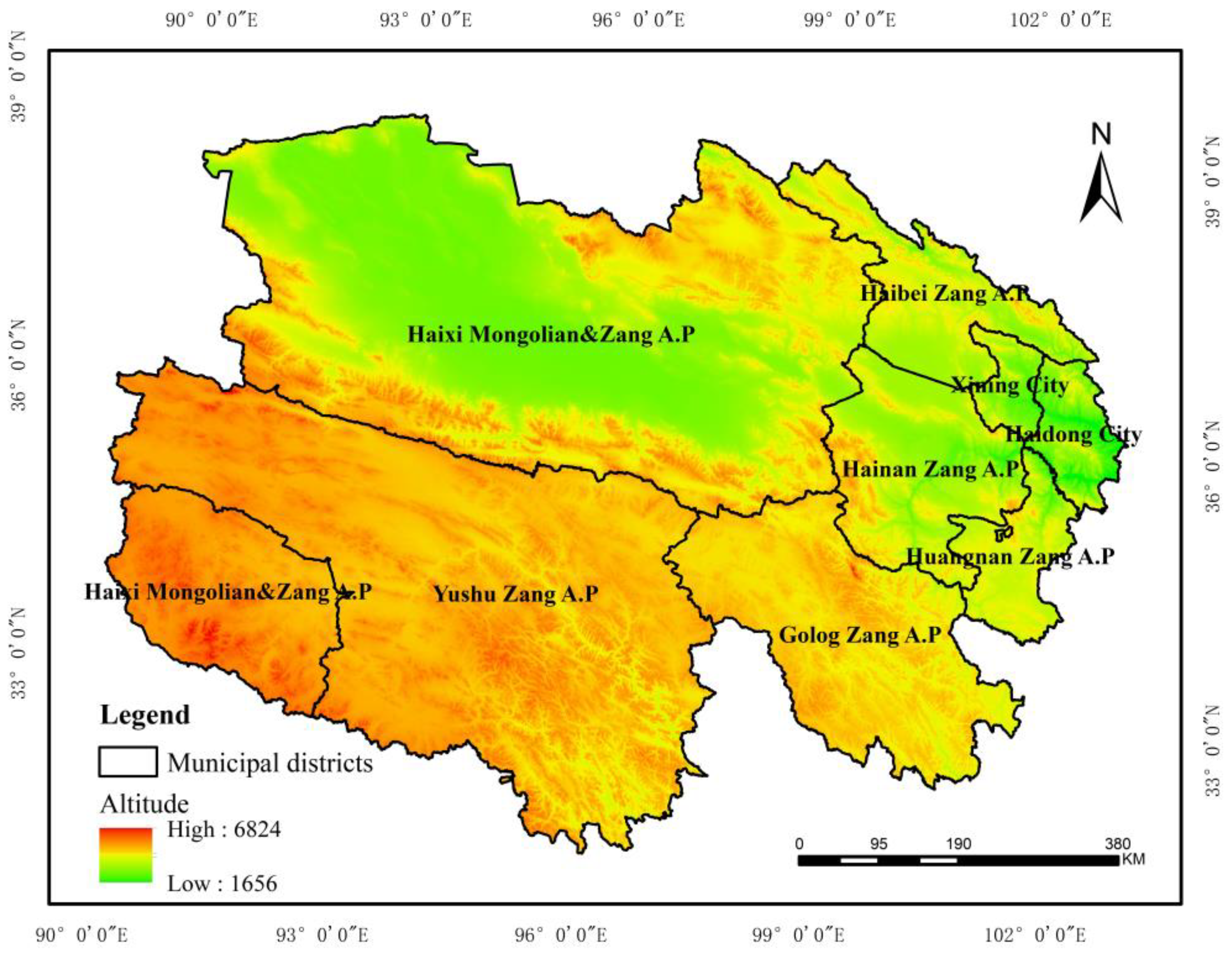
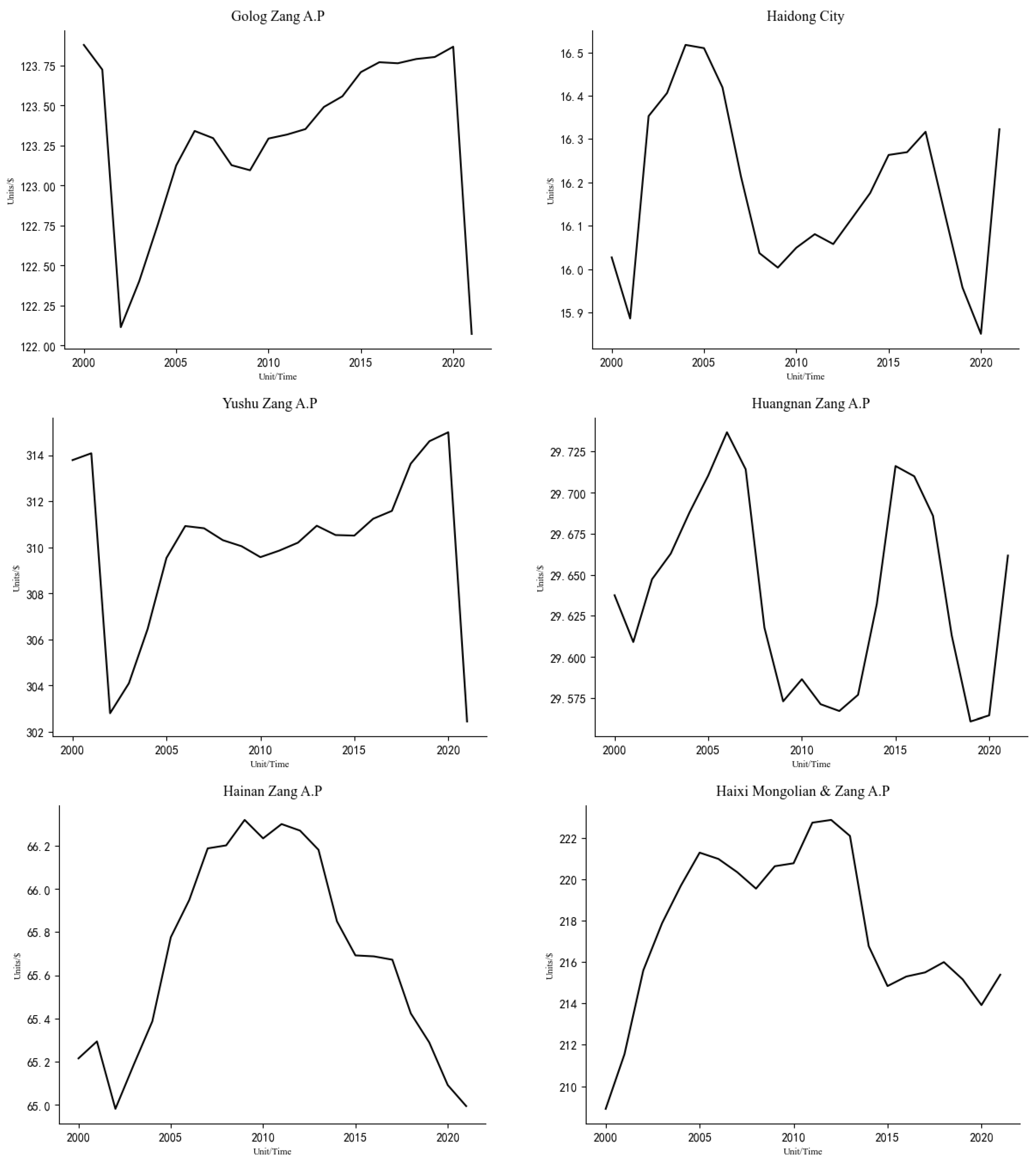
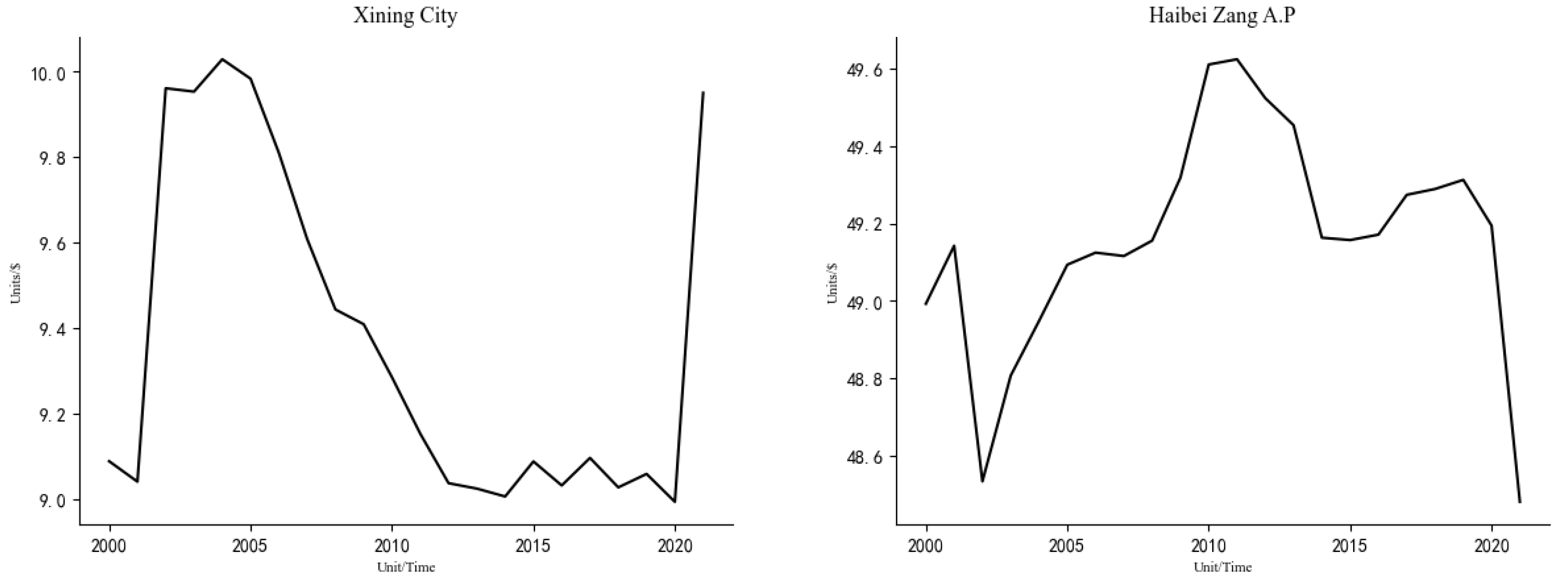
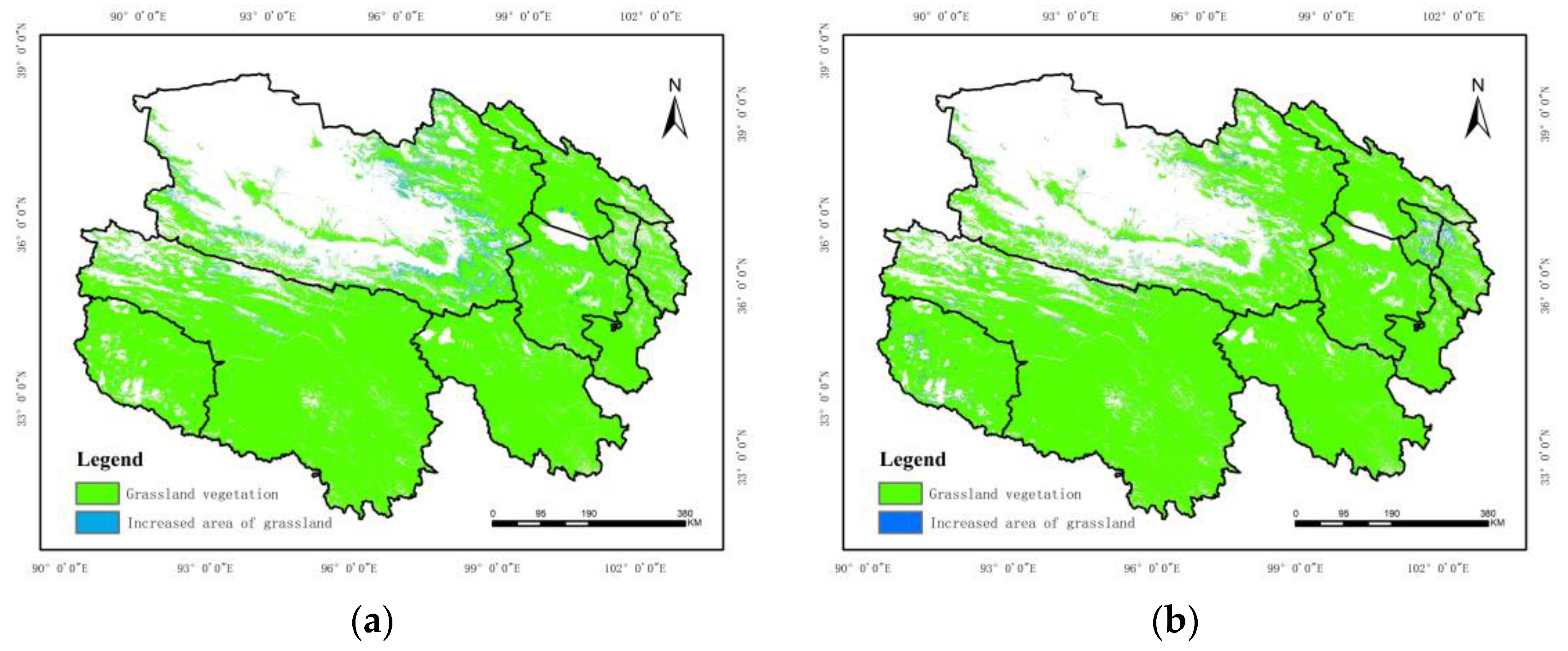
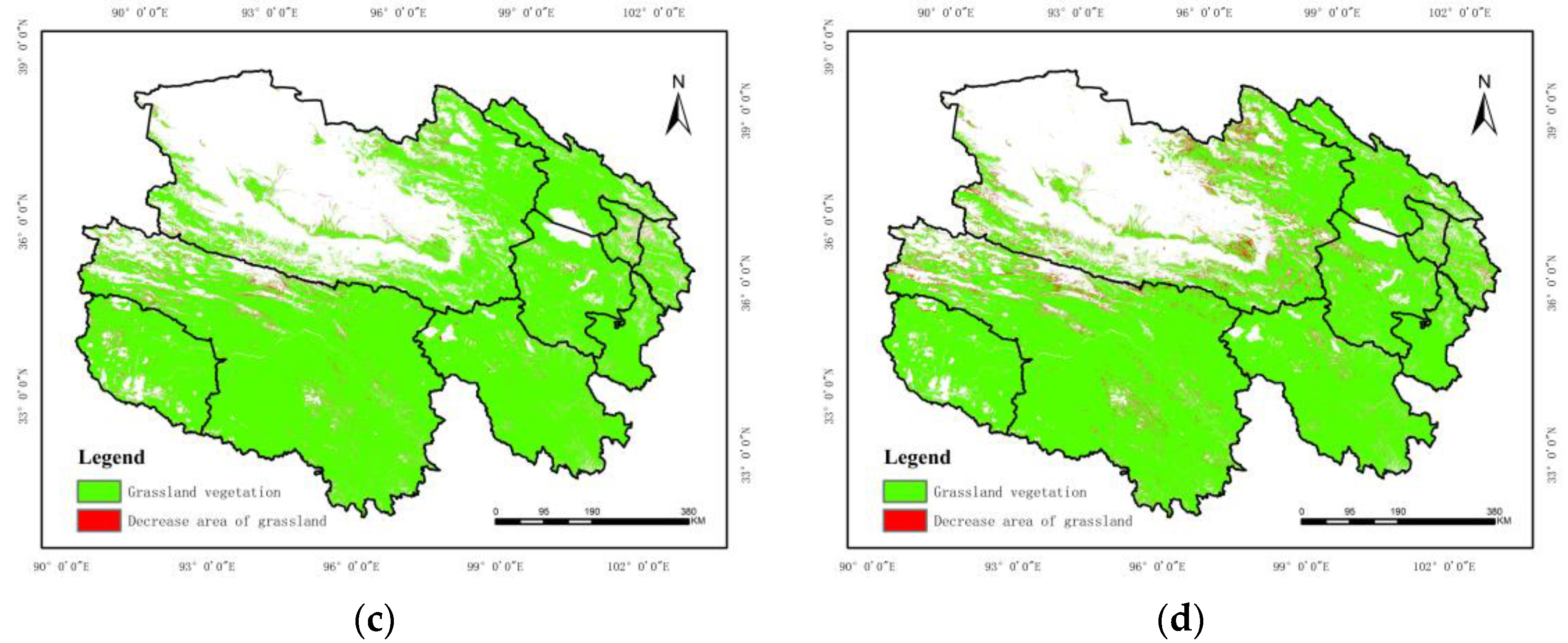
| Type of Livestock | Sheep | Cattle | Horses | Other Large Livestock |
|---|---|---|---|---|
| Conversion factor | 1 | 5 | 6 | 3 |
| Type | Ecosystems Services | Grass ($/hm2) |
|---|---|---|
| Regulating | Air regulation | 2.00 |
| Climate regulation | 899.82 | |
| Disturbance regulation | 2.00 | |
| Water regulation | 2.00 | |
| Erosion control | 235.43 | |
| Waste disposal | 869.44 | |
| Pollination | 49.61 | |
| Biological control | 73.54 | |
| Supporting | Habitat | 1105.21 |
| Soil formation | 1.45 | |
| Nutrient cycling | 0.00 | |
| Water supply | 54.58 | |
| Provisioning | Food sources | 1085.09 |
| Raw materials | 49.18 | |
| Genetic resources | 1105.21 | |
| Cultural | Recreation | 23.67 |
| Culture | 152.03 |
| Variable Category | Variable | Symbol |
|---|---|---|
| Explained variable | Value of grassland ecosystem services | lnGESV |
| Core explanatory variables | Average annual precipitation | lnPRCP |
| Average annual temperature | lnTMED | |
| Moderator | Grassland–livestock balance | GLB |
| Control variable | Gross domestic product of animal husbandry industry | lnGOV |
| Contribution rate of animal husbandry to primary industry | CRAH | |
| Number of livestock | lnNL | |
| Grassland resource supply | lnSNNP | |
| Per capita GDP | lnpcGDP | |
| Per capita livestock quantity | NAHpc | |
| Industrial structure level | Stru |
| Variable | N | Mean | SD | Min | Median | Max |
|---|---|---|---|---|---|---|
| lnGESV | 176 | 10.96 | 1.153 | 9.104 | 10.947 | 12.66 |
| GLB | 176 | −0.445 | 0.579 | −2.108 | −0.545 | 1 |
| lnTMED | 176 | 1.035 | 0.541 | −0.490 | 1.133 | 1.765 |
| lnPRCP | 176 | 0.575 | 0.290 | −0.248 | 0.648 | 1.031 |
| lnGOV | 176 | 11.64 | 0.854 | 9.961 | 11.698 | 13.32 |
| CRAH | 176 | 0.813 | 0.157 | 0.319 | 0.852 | 0.997 |
| lnSNNP | 176 | 20.71 | 1.809 | 19.25 | 20.618 | 42.60 |
| lnpcGDP | 176 | 9.788 | 1.024 | 7.864 | 9.821 | 12.78 |
| NAHpc | 176 | 15.26 | 11.44 | 0.871 | 16.531 | 51.02 |
| Stru | 176 | 0.770 | 0.163 | 0.318 | 0.787 | 0.977 |
| VARIABLES | Dependent Variable: Value of Grassland Ecosystem Services | |||
|---|---|---|---|---|
| Model 1 | Model 2 | Model 3 | Model 4 | |
| lnTMED | −1.6322 *** (−4.50) | −1.0857 ** (−2.97) | ||
| lnPRCP | −1.9704 ** (−3.03) | −2.6185 *** (−6.64) | ||
| lnGOV | −1.2183 ** (−3.49) | −0.9899 *** (−5.32) | ||
| CRAH | 0.0655 (0.10) | 1.4740 *** (3.64) | ||
| lnNL | 1.0926 (1.89) | −0.0604 (−0.16) | ||
| lnSNNP | 0.0461 (0.92) | 0.0334 (1.53) | ||
| lnpcGDP | 0.8975 ** (3.46) | 0.1090 (0.52) | ||
| NAHpc | −0.0566 ** (−2.41) | 0.0019 (0.24) | ||
| Stru | −3.2072 ** (−2.61) | −5.1011 *** (−8.51) | ||
| Constant | 12.6503 *** (37.02) | 13.1319 ** (2.39) | 12.0930 *** (35.60) | 25.2925 *** (8.01) |
| TIME | Yes | Yes | Yes | Yes |
| ID | No | No | No | No |
| Observations | 176 | 176 | 176 | 176 |
| R-squared | 0.5559 | 0.8743 | 0.2362 | 0.9397 |
| VARIABLES | Lag Term | High-Dimensional Fixation | Air Movement Index | Mean Humidity | ||
|---|---|---|---|---|---|---|
| Model 5 | Model 6 | Model 7 | Model 8 | Model 9 | Model 10 | |
| L.lnTMED | −1.6096 *** (−9.56) | |||||
| L.lnPRCP | −2.7928 *** (−6.36) | |||||
| lnTMED | −0.0258 * (−1.94) | −4.9782 *** (−2.90) | ||||
| lnPRCP | −0.0071 (−0.29) | −2.8386 *** (−12.21) | ||||
| lnsun | 6.1292 *** (4.67) | −0.3909 (−0.23) | 0.0635 (1.15) | 0.0529 (0.91) | 10.9519 ** (2.39) | −3.8435 *** (−6.45) |
| lnGOV | −0.8469 *** (−4.11) | −0.9639 *** (−4.62) | 0.0218 * (1.91) | 0.0195 * (1.69) | 0.7598 (0.90) | −0.6626 *** (−5.23) |
| CRAH | −0.5452 (−1.00) | 1.5473 ** (3.21) | −0.0005 (−0.03) | −0.0020 (−0.12) | 0.8579 (1.60) | 1.1462 *** (5.58) |
| lnNL | 0.6387 (1.37) | −0.0437 (−0.09) | 0.0648 *** (3.98) | 0.0638 *** (3.85) | 0.6977 (1.40) | 0.6827 *** (3.16) |
| lnpcGDP | 0.3651 * (2.09) | 0.1259 (0.51) | 0.0457 *** (5.13) | 0.0472 *** (5.24) | −0.5075 (−0.74) | 0.6135 *** (6.28) |
| NAHpc | −0.0409 * (−2.26) | 0.0037 (0.28) | −0.0027 *** (−4.07) | −0.0025 *** (−3.80) | −0.0726 *** (−3.78) | 0.0054 (0.63) |
| Stru | −1.5169 *** (−3.62) | −5.1388 *** (−8.15) | −0.0610 * (−1.75) | −0.0696 ** (−1.99) | 7.0620 (1.39) | −4.3572 *** (−9.65) |
| Constant | −31.0360 *** (−3.57) | 28.6045 ** (2.49) | 9.4780 *** (20.32) | 9.5624 *** (19.47) | −83.3590 ** (−2.05) | 42.7595 *** (8.62) |
| Time | Yes | Yes | Yes | Yes | Yes | Yes |
| ID | No | No | Yes | Yes | No | No |
| Observations | 168 | 168 | 176 | 176 | 176 | 176 |
| R-squared | 0.9038 | 0.9390 | 0.9999 | 0.9999 | 0.1324 | 0.8812 |
| VARIABLES | Dependent Variable: Value of Grassland Ecosystem Services | |||
|---|---|---|---|---|
| Model 11 | Model 12 | Model 13 | Model 14 | |
| lnTMED | 0.0001 (0.04) | −0.0438 ** (2.37) | ||
| lnPRCP | 0.0153 * (1.91) | 0.0002 (0.01) | ||
| lnsun | 0.0572 *** (4.32) | −0.0986 * (−1.74) | 0.0723 *** (5.64) | −0.0746 (−1.02) |
| lnGOV | −0.0029 (−1.19) | −0.0257 *** (−3.26) | −0.0027 (−1.13) | −0.0209 ** (−2.45) |
| CRAH | 0.0056 (0.86) | 0.0661 *** (3.84) | 0.0050 (0.82) | 0.0655 *** (3.62) |
| lnNL | −0.0143 * (−1.88) | 0.0983 *** (4.01) | −0.0166 ** (−2.24) | 0.0994 *** (3.96) |
| lnpcGDP | 0.0055 (1.70) | 0.0343 *** (5.53) | 0.0060 * (1.83) | 0.0312 *** (4.78) |
| NAHpc | 0.0006 ** (2.44) | −0.0087 *** (−13.23) | 0.0006 ** (2.78) | −0.0088 *** (−14.27) |
| Stru | −0.0126 (−0.74) | −0.2143 *** (−5.54) | −0.0132 (−0.75) | −0.2044 *** (−5.15) |
| Constant | 11.0530 *** (98.19) | 10.7862 *** (21.83) | 10.9326 *** (101.89) | 10.6217 *** (16.67) |
| Observations | 88 | 88 | 88 | 88 |
| R-squared | 1.0000 | 0.9998 | 1.0000 | 0.9998 |
| VARIABLES | Dependent Variable: Value of Grassland Ecosystem Services | |||
|---|---|---|---|---|
| Model 15 | Model 16 | Model 17 | Model 18 | |
| lnTMED | −2.9496 ** (−3.67) | −0.6511 ** (−3.98) | ||
| lnPRCP | −1.9654 *** (−12.90) | −1.0655 (−1.27) | ||
| lnsun | −0.5296 (−0.32) | 1.0675 (1.05) | −0.1546 (−0.13) | −2.2398 * (−2.82) |
| lnGOV | −1.2553 ** (−3.76) | −0.8069 ** (−5.19) | −0.8497 ** (−4.47) | −0.9700 *** (−7.31) |
| CRAH | −1.6888 ** (−3.73) | 2.4189 ** (4.85) | 0.0200 (0.05) | 2.3063 ** (5.13) |
| lnNL | 1.1669 * (2.54) | 1.7673 *** (7.08) | 0.5701 * (2.53) | 1.7309 *** (6.19) |
| lnpcGDP | 0.0798 (0.49) | −0.1070 (−0.57) | 0.4478 (1.78) | −0.1639 (−0.80) |
| NAHpc | −0.0409 (−0.93) | −0.0399 ** (−4.72) | 0.0062 (1.33) | −0.0310 ** (−4.29) |
| Stru | 5.5379 ** (3.50) | −3.1240 ** (−4.33) | −2.2505 (−1.46) | −4.2158 *** (−6.58) |
| Constant | 22.7233 * (2.72) | 3.3924 (0.45) | 16.7093 (2.31) | 32.9759 *** (5.85) |
| Observations | 88 | 88 | 88 | 88 |
| R-squared | 0.9636 | 0.9733 | 0.9897 | 0.9622 |
| VARIABLES | Dependent Variable: Value of Grassland Ecosystem Services | |||
|---|---|---|---|---|
| Model 19 | Model 20 | Model 21 | Model 22 | |
| lnTMED | 0.0101 ** (2.29) | −0.0066 (−0.61) | ||
| lnPRCP | 0.0450 *** (2.88) | −0.0169 (−0.93) | ||
| lnsun | 0.0334 (0.94) | 0.0002 (0.01) | 0.0872 *** (3.89) | −0.0204 (−0.50) |
| lnGOV | −0.0049 (−0.50) | −0.0247 *** (−3.62) | −0.0039 (−0.47) | −0.0253 *** (−3.78) |
| CRAH | −0.0611 ** (−2.78) | 0.0648 *** (3.66) | −0.0519 ** (−2.56) | 0.0632 *** (3.92) |
| lnNL | −0.0213 (−1.21) | 0.0654 *** (3.79) | −0.0164 (−1.02) | 0.0670 *** (4.16) |
| lnpcGDP | 0.0052 (0.52) | 0.0281 *** (4.39) | 0.0065 (0.72) | 0.0279 *** (4.38) |
| NAHpc | 0.0009 ** (2.44) | −0.0031 *** (−3.62) | 0.0007 * (2.01) | −0.0031 *** (−3.64) |
| Stru | −0.0018 (−0.06) | −0.1017 * (−1.89) | −0.0087 (−0.30) | −0.0972 * (−1.73) |
| Constant | 12.1196 *** (38.97) | 9.9028 *** (29.90) | 11.6290 *** (51.23) | 10.0655 *** (27.13) |
| Observations | 66 | 110 | 66 | 110 |
| R-squared | 0.9995 | 0.9995 | 0.9996 | 0.9995 |
| VARIABLES | GLB | lnGESV | ||
|---|---|---|---|---|
| Model 23 | Model 24 | Model 25 | Model 26 | |
| GLB | 1.2570 *** (22.90) | 1.0492 *** (12.26) | ||
| lnTMED | −0.4901 *** (−4.68) | −0.4696 *** (−6.31) | ||
| lnPRCP | −1.6424 *** (−15.14) | −0.8954 *** (−4.98) | ||
| lnGOV | −0.8727 *** (−9.72) | −0.6428 *** (−10.88) | −0.1214 (−1.59) | −0.3155 *** (−3.84) |
| CRAH | −0.3797 * (−1.72) | 0.4487 *** (2.93) | 0.5428 *** (3.67) | 1.0032 *** (6.15) |
| lnNL | −0.4399 *** (−3.24) | −1.1001 *** (−11.72) | 1.6456 *** (17.64) | 1.0937 *** (8.09) |
| lnSNNP | 0.0620 *** (3.98) | 0.0511 *** (4.90) | −0.0319 *** (−2.93) | −0.0202 * (−1.73) |
| lnpcGDP | 0.1898 *** (3.24) | −0.3210 *** (−6.03) | 0.6589 *** (16.37) | 0.4457 *** (7.24) |
| NAHpc | −0.0269 *** (−5.43) | 0.0081 ** (2.13) | −0.0229 *** (−6.36) | −0.0066 (−1.64) |
| Stru | −2.1296 *** (−4.53) | −2.7526 *** (−11.32) | −0.5303 (−1.59) | −2.2131 *** (−6.42) |
| Constant | 12.1186 *** (7.44) | 18.4073 *** (18.58) | −2.1013 * (−1.66) | 5.9801 *** (3.18) |
| Observations | 176 | 176 | 176 | 176 |
| R-squared | 0.7529 | 0.8894 | 0.9728 | 0.9704 |
Disclaimer/Publisher’s Note: The statements, opinions and data contained in all publications are solely those of the individual author(s) and contributor(s) and not of MDPI and/or the editor(s). MDPI and/or the editor(s) disclaim responsibility for any injury to people or property resulting from any ideas, methods, instructions or products referred to in the content. |
© 2024 by the authors. Licensee MDPI, Basel, Switzerland. This article is an open access article distributed under the terms and conditions of the Creative Commons Attribution (CC BY) license (https://creativecommons.org/licenses/by/4.0/).
Share and Cite
Zhang, J.; Chen, P. Have Climate Factor Changes Jeopardized the Value of Qinghai Grassland Ecosystem Services within the Grass–Animal Balance? Sustainability 2024, 16, 8463. https://doi.org/10.3390/su16198463
Zhang J, Chen P. Have Climate Factor Changes Jeopardized the Value of Qinghai Grassland Ecosystem Services within the Grass–Animal Balance? Sustainability. 2024; 16(19):8463. https://doi.org/10.3390/su16198463
Chicago/Turabian StyleZhang, Jize, and Pengwei Chen. 2024. "Have Climate Factor Changes Jeopardized the Value of Qinghai Grassland Ecosystem Services within the Grass–Animal Balance?" Sustainability 16, no. 19: 8463. https://doi.org/10.3390/su16198463
APA StyleZhang, J., & Chen, P. (2024). Have Climate Factor Changes Jeopardized the Value of Qinghai Grassland Ecosystem Services within the Grass–Animal Balance? Sustainability, 16(19), 8463. https://doi.org/10.3390/su16198463





